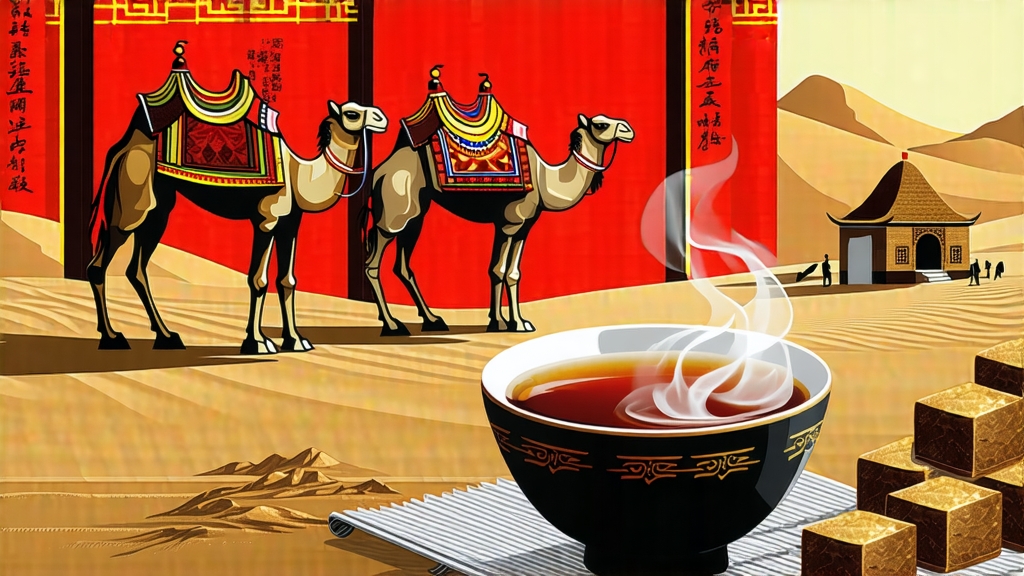
Among the six major families of Chinese tea, dark tea—hei cha—remains the least explored beyond China’s borders, yet it once lubricated the wheels of Eurasian trade and still carries the microbial magic of centuries. Within this shadowy category, Fu brick tea from Hunan province is perhaps the most charismatic: it is the only tea deliberately infected with a beneficial mold that blooms into golden flecks nicknamed “Golden Flowers,” and its flavor evolves for decades like a living library of caravan routes, monsoon air and oak-paneled age.
-
From Frontier Necessity to Imperial Tribute
The story begins in the early Ming dynasty (1368-1644), when the imperial court exchanged tea for warhorses with Central Asian tribes. Compressed bricks traveled better than loose leaves, and the humid trek along the Silk Road triggered spontaneous fermentation. By 1860 merchants in Jingyang county, Shaanxi, built specialized “Fu tea factories” (Fu means “attached” or “subsidiary,” indicating the brick’s secondary processing after rough maocha arrives from Hunan). Because the Qing government granted exclusive licenses marked with the Chinese character fu, the name stuck. Caravans departing Xi’an carried 3.5 kg black slabs westward; Tibetan monks used them as currency, and Russian aristocrats later served Fu brick infusion in samovars, believing it eased the digestion of mutton fat. -
Terroir and Leaf Architecture
Authentic Fu brick relies on a specific leaf blueprint: the large-leaf Assamica variety grown between 300–800 m in the mist-locked Qinling and Wuling ranges. After the spring harvest, leaves are withered, pan-fired, rolled and sun-dried into rough maocha, then trucked to Jingyang or Yiyang where the real alchemy begins. The cool, semi-arid climate of these northern towns—far from the tea gardens—creates the low-temperature, moderate-humidity conditions required for Eurotium cristatum to dominate without inviting destructive molds. -
Crafting a Living Brick
Step 1: Moistening and Pile-Fermentation
Maocha is sprayed to 28–30 % moisture, stacked 70 cm high and kept at 55 °C for 6–8 hours. This “wet piling” pre-conditions microbes and softens fiber, preparing the leaf to bond under pressure.
Step 2: Steam-softening and Molding
The tea is steamed for 90 seconds, just long enough to become plastic, then fed into iron molds lined with cotton paper. A 5-ton hydraulic press squeezes the mass into a 2 kg rectangular slab; the density is critical—too loose and oxygen will spoil the tea, too tight and the Golden Flowers cannot breathe.
Step 3: The Flowering Room
Bricks are transferred to a pine-wood chamber kept at 26 °C and 75 % RH. Within 3 days Eurotium cristatum spores germinate, forming tiny yellow globes. By day 12 the surface is dusted with “Golden Flowers” (jin hua). Technologists monitor CO₂ levels; if the count drifts above 6,000 ppm the bricks are rotated to prevent anaerobic sourness.
Step 4: Drying and Maturation
The bricks spend one week in a low-temperature dryer (35 °C) until moisture drops to 9 %. Then they are wrapped in bamboo bark and stacked in ventilated warehouses for a minimum of one year; vintage lots rest for ten or more. During this time phenolic compounds condense into theaflavins and theabrownins, while a faint coumarin note—reminiscent of toasted hay—emerges.
-
Decoding the Golden Flower
Eurotium cristatum is a xerophytic fungus unique to Fu brick. Its golden cleistothecia secrete extracellular enzymes that cleave large catechins into smaller, less astringent fragments and produce the polyketide asterric acid, imparting a subtle apricot aroma. Chinese researchers have measured a positive correlation between flower density (≥ 500,000 colonies per gram of dry leaf) and the tea’s ability to modulate blood lipids, though Western peer review is still pending. -
Variations on a Brick
Traditional Fu brick: 2 kg, 14 % flowers, malty cocoa finish.
Mini Fu brick: 200 g, designed for urban drinkers, same microbial protocol.
Fu zhuan “tribute